Powerdynamo regresa el encendido
y la luz
a su moto clásica
|
|
Powerdynamo regresa el encendido |
|
|||
|
¡Apesadumbrado! |
versión 28.09.2010 |
|
|
Por favor lea primero las instrucciones completamente antes de empezar con la instalación o la modificación de las piezas. Tenga en cuenta las llamadas de atención en la página de informaciones para el sistema. |
| Si no tenga conocimientos técnicos para la instalación, entonces por favor deje realizarla de una persona cualificada o de un taller técnico correspondiente. Una instalación inadecuada causa daño tanto en el nuevo sistema como en la motocicleta. | |
| Antes de pedir el sistema, por favor comprueba mediante la lista de paquetes (o bien la foto
"piezas en volumen de entrega") si la herramienta recomendada de nosotros para
extraer el rotor (extractor) está contenida en el volumen de
entrega. En caso negativo por lo mejor pídala también directamente.
¡En caso de daño al rotor por usar otros herramientas y medios (inadecuados), el derecho de garantía
prescribe! Cuando un rotor está sentado demasiado bajo (por cualquier causa), toca y destruye la unidad de estator que está debajo. |
|
| Si tiene acceso a Internet, vea esta documentación en línea. Puede ampliar los imagenes por cliquear sobre ellos y entonces recibe más
informaciones. Lista del sistema en: http://www.powerdynamo.biz |
|
|
|
El rotor es muy sensible a efectos de golpes (por ejemplo mientras el transporte). |
| Compruebe en cada caso antes de la instalación de la pieza el estado fijo de los magnéticos por intentar apartarlos con los dedos al
lado. Después de efectos de golpes, algunos de los magnéticos pegados podrían haberse soltados y podrían estar fijándose solamente por su poder magnético que resultaría en daños graves en el dispositivo mientras el funcionamiento. Al mismo tiempo, por favor comruebe los magnéticos del rotor por cuerpos extraños (por ejemplo tornillos u otros objetos metállicos). |
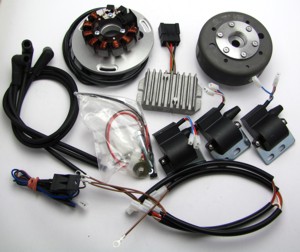 |
Estas partes las debe haber recibido:
|
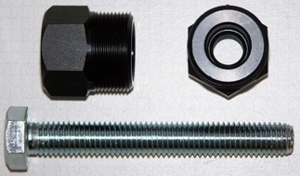 |
Para retirar el nuevo rotor necesita un extractor M27x1.25 (Número de partes: 99
99 799 00 -No
en el alcance de la fuente!-).
ATENCIÓN: ¡Al usar un extractor de garras se sueltan los imanes en el rotor! |
|
|
|
|
|
|
| Please note: If you drive the motorcycle with this system without battery (which is no problem for the system itself) AND use side indicators and/or electronic equipment you will have to install a large capacity condenser or opt for an alternative regulator with build in condenser to smoothen the frequency of the voltage. | |
|
|
|
| Make sure your motorcycle rests securely on her stand, preferably on an elevated work bench and that you have good access to the generator side of the engine. | |
|
|
|
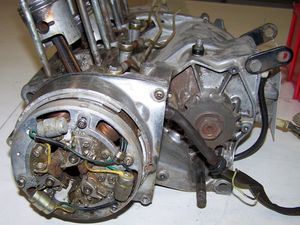 |
Disconnect all wires from the old
magneto, the
ignition coils, the rectifier and the regulator and remove these parts.
Take the woodruff key from the crank. You will not need it anymore. Please do not forget to do so, otherwise you will have trouble later on in the assembly. (Remark: This woodruff key does not actually hold your rotor on the shaft, this is done by the cone. It simply guides to the correct setting which will now be otherwise achieved.) |
|
|
|
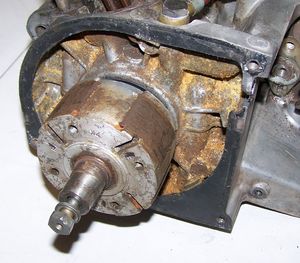 |
Take the old magnet rotor off. You will need a puller tool for this. |
|
|
|
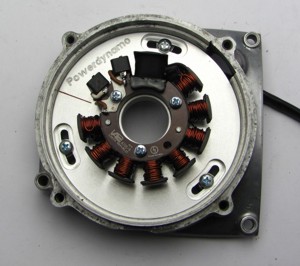
|
The new stator base is fixed into the cover with the 3 countersunk screws supplied. |
|
|
|
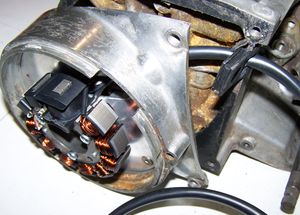 |
Place the cover, now with the new stator coils back onto the engine.
Insert the rubber grommet supplied on the harness into the outlet
recess (cut the surplus rubber material).
Make sure the cover sits correctly on the engine (mind the centering studs there). |
|
|
|
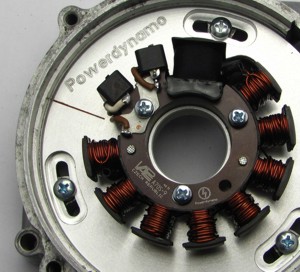 |
Have a look at the new stator. You will find there a small red marking somewhat left of the black coils (here in the picture encircled red). This is an ignition marking. |
|
|
|
|
Have a look at the new rotor. You will find on its circumference a small
pressed in line. That is an ignition marking too. It is durable, but not well visible, so better highlighten it with some marker
pen, preferably on top of the flywheel. The rotor is missing 3 magnets 120 degrees apart. This is wanted and not a defect, those magnetic holes trigger ignition. The rotor might have an arrow pointing clockwise. This is no problem, important is that the stator is made for anticlockwise turning systems, such as this Kawasaki. |
|
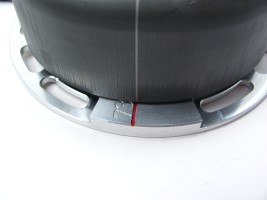 |
|
|
|
|
|
Take the spark plugs out and bring the piston into ignition position.
This should be 23 degrees BTDC). You could move the piston by putting the rotor loosely onto the crank shaft and turning it. Check that it may move freely above the stator base. Please do bear in mind hat the S1 turns anti-clockwise. So you have to turn the rotor clockwise for reaching the ignition point after you had TDC. |
|
|
|
Once you have found the correct ignition point, take the rotor carefully off again without changing the
crank's position and reset it onto the crank in such a way that the
marking on the rotor aligns with the marking on the stator. In that
position fasten the rotor carefully with the new rotor screw supplied.
Take care not to change the crank's (ignition) position. Otherwise you have to redo this procedure.
(Picture for demonstration only!) |
|
|
|
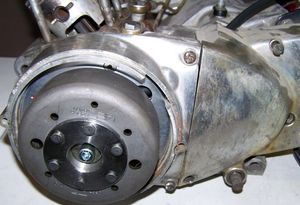
|
The works at the engine are finished. Screw the spark plugs in again. |
|
|
|
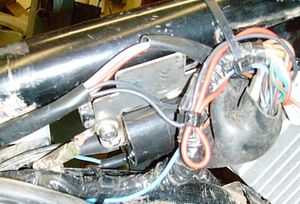 |
You will now have to fasten the 3 ignition coils and the new regulator/rectifier to the frame of the motorcycle. |
|
|
|
|
Integration of the Power Dynamo electronic ignition and generator to
the S1 (points ignition) wiring:
After installing the new stator, regulator and CDI Coil connect them together according to the Power Dynamo instructions further down this page. This sets up ignition wiring and lighting voltage production. If you drive with battery, engine switch off can be implemented as before by turning the main switch off, if you connect the orange wire running formerly to the original ignition coils to the black wire of the new relay. The orange wire carries plus when the main switch is on. It than activates the relay and opens the cut-off circuit so that ignition may run. Switched off, the relay will fall back and close ignition by putting the blue wire of the new ignition coil to ground. If you want to drive without battery (which technically you may) this orange wire remains idle (But please insulate well!). You will than have to facilitate engine stop by some extra kill switch (see below). You must now integrate the new lighting system into your bikes wire harness. Here you connect via an additional new fuse the red wire from the new
regulator. |
|
|
|
|